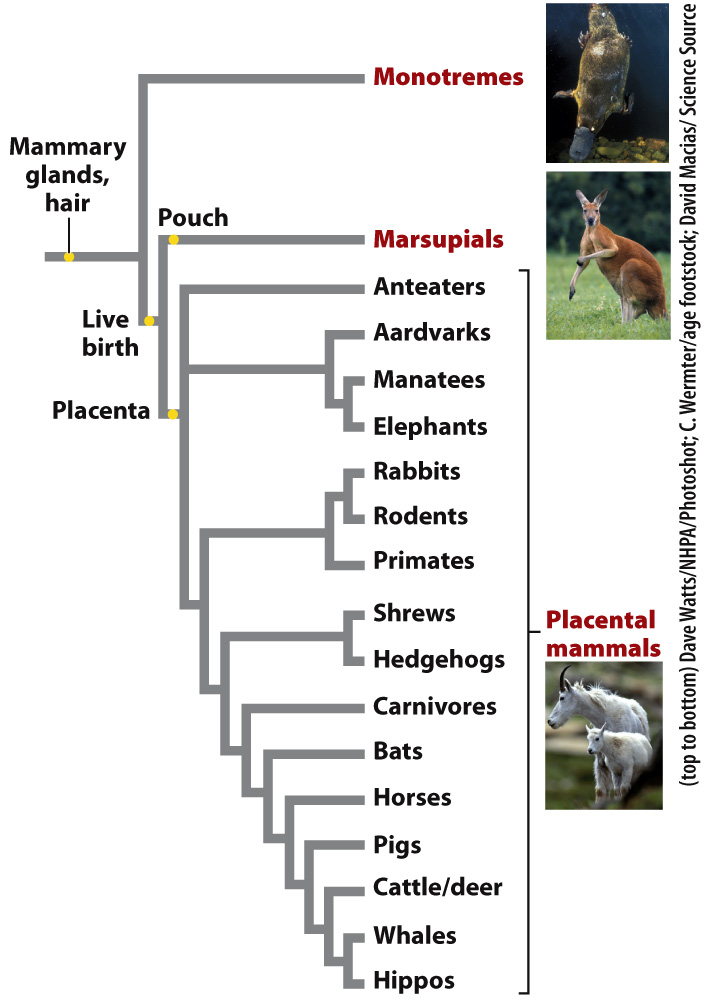Amniotes evolved terrestrial eggs.
Like insects, some vertebrates evolved an egg adapted to tolerate dry conditions that accompany life on land. The amniotic egg has a desiccation-
The amniotic egg can exchange gases while retaining water, and so permits the group of vertebrates known as amniotes to live in dry terrestrial habitats that amphibian eggs cannot tolerate. Amniotes include lizards, snakes, turtles, and crocodilians (about 6000 species of scaly animals commonly referred to as reptiles), as well as birds and mammals (Fig. 44.37). Most mammals, many lizards, and some snakes have evolved live birth rather than laying eggs. Nonetheless, they retain the specialized membranes characteristic of all amniotes. Instead of being wrapped around the embryo inside a tough egg shell, these membranes surround and protect the embryo inside the womb.

As shown in Fig. 44.31, amniotes form a monophyletic group with two major branches. One are the mammals, and the other contains turtles, birds, and the amniotes traditionally grouped together as reptiles. Like fish, however, reptiles are not monophyletic —birds are descended from reptiles, although you have to look closely to see the similarities between the two groups. Birds lack teeth, most of their scales have been modified into feathers (except on the legs and toes), and they are generally adapted for flight. Adaptations for flight include hollow bones that are light but remain strong, and a method of breathing that extracts much oxygen from each breath, permitting high-
One consequence of this streamlined, lightweight body is a lack of the heavy jaws that many other tetrapods use to grind up plant leaves or other low-
Quick Check 5 Why do bird feet have scales like those found on snakes and lizards?
Quick Check 5 Answer
Scales are found on all these animals because they were present in a common ancestor. Even feathers are modified scales.
All mammals are covered with hair and feed their young milk from the mammary glands for which the class Mammalia is named. Like many other groups of animals and plants, the early-

971
The first mammals that gave birth to live young appeared in the Jurassic Period, about 160 million years ago. These animals gave rise to the two major living groups, marsupial and placental mammals. Marsupials include kangaroos, koalas, and related groups native to Australia, as well as the opossums found in the Americas. Their young are born at an early stage of development, and the tiny babies must crawl to a pouch where mammary glands equipped with nipples provide them with milk. Only later do fully formed juveniles emerge from the pouch and begin life on the ground.
The placental mammals are named for a temporary organ called the placenta that develops in the uterus along with the embryo, providing nutrition that enables the offspring to be larger and more quickly independent when born (Chapter 42). Most living mammals fall into this group. Placental mammals include the carnivores, such as lions and weasels; the primates, including monkeys, apes, and humans; and the hooved mammals, which include cattle, pigs, deer, and—
All together, the familiar mammals mentioned so far number about 1000 species. The most diverse mammals, however, belong to two groups of mostly small animals, the bats and the rodents. Bats, which evolved flight and a form of sonar called echolocation to find food at night, include more than 1000 species. The largely plant-
972